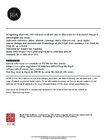| dc.contributor.creator | Dalton, Catherine | |
| dc.contributor.creator | Jennings, Eleanor | |
| dc.contributor.creator | O'Dwyer, Barry | |
| dc.contributor.creator | Taylor, David | |
| dc.date.accessioned | 2018-10-18T11:23:13Z | |
| dc.date.available | 2018-10-18T11:23:13Z | |
| dc.date.issued | 2016 | |
| dc.identifier.citation | Dalton, C., Jennings, E., O’Dwyer, B. and Taylor, D. 2016 Integrating observed, inferred and simulated data to illuminate environmental change: a limnological case study. Biology and Environment: Proceedings of the Royal Irish Academy 2016. DOI: 10.3318/ BIOE.2016.24 | en_US |
| dc.identifier.uri | http://hdl.handle.net/10395/2293 | |
| dc.description | Integrating observed, inferred and simulated data to illuminate environmental change: a limnological case study | en_US |
| dc.description.abstract | Effective management of aquatic ecosystems requires knowledge of baseline conditions and pastvariations in stressors and their effects in order to mitigate the impacts of future variability and change. This study utilizes combined monitoring, sedimentary and hindcast computer model data to reconstruct and examine the eutrophication history of a lake in southwest Ireland over a c.60-year period and uses computer models to simulate future responses in water quality as a result of projected changes in land use and climate. The study site, Lough Leane, has major national and international importance, but is currently regarded as ‘at significant risk’ of not meeting the water quality objectives of the EU Water Framework Directive. Palaeolimnological reconstructions and hindcast modelling results confirmed that current eutrophication in the lake dates at least to the 1950s, and particularly from the 1970s. When used to simulate future conditions the same computer models indicated that climate change will likely worsen the current situation. The approach described, synthesising data from a range of sources, can inform future-proofing of lake management plans and objectives by enabling the accommodation of future changes in catchment and climate conditions. | en_US |
| dc.language.iso | eng | en_US |
| dc.publisher | Royal Irish Academy | en_US |
| dc.relation.ispartofseries | 116B;3 | |
| dc.rights.uri | https://www.jstor.org/stable/10.3318/bioe.2016.24 | en_US |
| dc.subject | Integrating | en_US |
| dc.subject | Observed data | en_US |
| dc.subject | Inferred data | en_US |
| dc.subject | Simulated data | en_US |
| dc.subject | Environmental change | en_US |
| dc.subject | Limnological | en_US |
| dc.subject | Biology | en_US |
| dc.subject | Environment | en_US |
| dc.title | Integrating observed, inferred and simulated data to illuminate environmental change: a limnological case study | en_US |
| dc.type | Article | en_US |
| dc.type.supercollection | all_mic_research | en_US |
| dc.type.supercollection | mic_published_reviewed | en_US |
| dc.description.version | Yes | en_US |
| dc.identifier.doi | 10.3318/ BIOE.2016.24 | |


